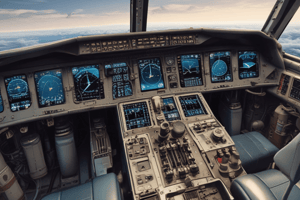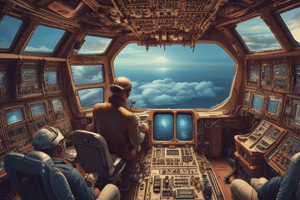Podcast
Questions and Answers
What are the three rotations that can occur based on flight attitude changes?
What are the three rotations that can occur based on flight attitude changes?
- Pitch
- Roll
- Yaw
- All of the above (correct)
Forces are generated aerodynamically by deflection of control surfaces on the wings and the empennage.
Forces are generated aerodynamically by deflection of control surfaces on the wings and the empennage.
True (A)
Unaccelerated Level Flight is maintained when the lift (L) is equal to the _____ (W) plus the LTHS.
Unaccelerated Level Flight is maintained when the lift (L) is equal to the _____ (W) plus the LTHS.
W
What does a bleed air system conduct in most turbofan powered aircraft?
What does a bleed air system conduct in most turbofan powered aircraft?
Which of the following are sources of bleed air? (Select all that apply)
Which of the following are sources of bleed air? (Select all that apply)
What are the uses of high pressure air provided by the pneumatic system? (Select all that apply)
What are the uses of high pressure air provided by the pneumatic system? (Select all that apply)
Bleed air is used for a number of functions including ECS, Wing/Engine Anti-Icing, Water Pressurization, Hydraulic Reservoir Pressurization, and __________.
Bleed air is used for a number of functions including ECS, Wing/Engine Anti-Icing, Water Pressurization, Hydraulic Reservoir Pressurization, and __________.
Flashcards are hidden until you start studying
Study Notes
Flight Control Systems
- An aeroplane has 6 degrees of freedom: Lateral Axis (y), Pitch (Theta, Q), Roll (Phi, F), Yaw (Psi, Y), Long Axis (x), and Vertical Axis (z)
- Forces and moments: change of flight attitude caused by the resulting moments around the respective axis → moment = force x lever
- Change of attitude: Pitch → rotation around the lateral axis, Roll → rotation around the longitudinal axis, Yaw → rotation around the vertical axis
- Forces are generated aerodynamically by deflection of control surfaces on the wings and the empennage
- Flight control surfaces: Rudder, Elevator, Aileron
- Unaccelerated level flight: L = LTHS (Trimmable Horizontal Stabilizer), W = L + LTHS
- Pitch (Up): deflection of elevator (Up → Downforce)
- Roll (to the Right): deflection of aileron (Right-hand turn)
- Yaw (to the Right): deflection of rudder (to the right)
- Secondary flight controls: Spoiler, Airbrakes, Horizontal Stabilizer, Flaps
A320 System Architecture
- Hydraulic system users: GREEN, BLUE, YELLOW
- Wing: Computer number
- A320 Fly-by-wire: Sidestick, Electrical transmission and data processing, Hydraulic/electrical movement of the control surfaces
- Rudder pedals: controlled by the rudder pedals
Bleed Air Systems
- A bleed air system conducts medium to high-pressure air from the compressor stage of the engine(s) and APU to various locations within the aircraft
- Sources of bleed air: Engines, APU, High pressure ground air
- Users of bleed air: Environmental Control System (ECS), Wing & Engine anti-icing, Water system pressurization, Hydraulic reservoir pressurization, Engine starting
- System architecture: Network of ducts, valves, and regulators
- Control panel: virtual tour: https://ccntservice.airbus.com/apps/cockpits/a320/
- System display: BLEED page → ENG bleed air, APU bleed air
Studying That Suits You
Use AI to generate personalized quizzes and flashcards to suit your learning preferences.




